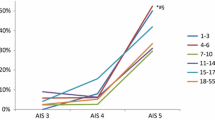Summary
An analysis of 420 patients 60 or more years of age showed that even very mild brain injuries may be dangerous for the aged. Only one third of 174 patients with cerebral contusion made a useful recovery; of the 101 patients with cerebral contusion unconscious for six hours or more, 78 died, and only 11 made a useful recovery. The outcome in patients with acute intracramal haematomas or depressed skull fractures was poor. Even the aged with brain injuries may benefit from an intensive effort at treatment. This effort should, however, be strictly limited in time. With the present means of treating brain injury it seems futile to use limited intensive treatment resources for an acute brain injury in a patient over 70 years of age who is unconscious on admission. In contrast to acute injuries, subacute and chronic subdural haematomas should be operated on promptly in spite of severe neurological impairment or advanced age.
Similar content being viewed by others
References
Becker, D. P., Miller, J. D., Ward, J. D., Greenberg, R. P., Young, H. F., Sakalas, R., The outcome from severe head injury with early diagnosis and intensive management. J. Neurosurg.47 (1977), 491–502.
Browne, L. A., Head injuries 1972–73. J. Irish med. Ass.70 (1977), 197–200.
Bruce, D. A., Schut, L., Bruno, L. A., Wood, J. H., Sutton, L. N., Outcome following severe head injuries in children. J. Neurosurg.48 (1978), 679–688.
Brun, H., Der Schädelverletzte und sein Schicksal. Bruns' Beitr. klin. Chir.38 (1903), 192–287, 289–407, 601–691.
Carlsson, C.-A., v. Essen, C., Löfgren, J., Factors affecting the clinical course of patients with severe head injuries. Part 1: Influence of biological factors. Part 2: Significance of posttraumatic coma. J. Neurosurg.29 (1968), 242–251.
Central Statistical Office of Finland, Statistics on Causes of Death.
Fell, D. A., Fitzgerald, S., Moiel, R. H., Caram, P., Acute subdural hematomas. Review of 144 cases. J. Neurosurg.42 (1975), 37–42.
Frowein, R. A., Terhaag, D., auf der Haar, K., Frühprognose akuter Hirnschädigungen. I. Teil: Bedeutung von Bewußtlosigkeitsdauer und Lebensalter. II. Teil: Die prognostische Bedeutung des neurologischen Syndroms. Katamnestische Ergebnisse überlebter langdauernder Bewußtlosigkeit. Akt. Traumatologie5 (1975), 203–211, 291–298.
Galbraith, S., Murray, W. R., Patel, A. R., Knill-Jones, R., The relationship between alcohol and head injury and its effect on the conscious level. Brit. J. Surg.63 (1976), 128–130.
Heiskanen, O., Epidural hematoma. Surg. Neurol.4 (1975), 23–26.
Heiskanen, O., Marttila, I., Valtonen, S., Prognosis of depressed skull fracture. Acta chir. scand.139 (1973), 605–608.
Heiskanen, O., Sipponen, P., Prognosis of severe brain injury. Acta neurol. scand.46 (1970), 343–348.
Heiskanen, O., Vapalahti, M., Temporal lobe contusion and haematoma. Acta Neurochir. (Wien)27 (1972), 29–35.
Hooper, R., Observations on extradural haemorrhage. Brit. J. Surg.47 (1959), 71–87.
Jamieson, K. G., Yelland, J. D. N., Depressed skull fractures in Australia. J. Neurosurg.37 (1972), 150–155.
Jamieson, K. G., Yelland, J. D. N., Surgically treated traumatic subdural hematomas. J. Neurosurg.37 (1972), 137–149.
Jennett, B., Assessment of the severity of head injury. J. Neurol. Neurosurg. Psychiat.39 (1976), 647–655.
Jennett, B., Bond, M., Assessment of outcome after severe brain damage. A practical scale. Lancet1 (1975), 480–484.
Jennett, B., Teasdale, G., Galbraith, S., Pickard, J., Grant, H., Braakman, R., Avezaat, C, Maas, A., Minderhoud, J., Vecht, C. J., Heiden, J., Small, R., Caton, W., Kurze, T., Severe head injuries in three countries. J. Neurol. Neurosurg. Psychiat.40 (1977), 291–298.
Karimi-Nejad, A., Tritz, W., Das Kopftrauma des alten Menschen. Hefte zur Unfallheilk.121 (1975), 417–429.
Lausberg, G., Kirchhoff, D., Redondo, J. A., Traumatismos cranianos na idade avançada. Arch. Neuro-psiquiat. (S. Paulo)32 (1974), 104–111.
Lewin, W., Tracheostomy in head injuries. Proc. roy. Soc. Med.52 (1959), 409–411.
Loew, F., Wüstner, D., Diagnose, Behandlung und Prognose der traumatischen Hämatome des Schädelinneren. Acta Neurochir. (Wien), Suppl. VIII, 1960.
McKissock, W., Richardson, A., Bloom, W. H., Subdural haematoma. A review of 389 cases. Lancet1 (1960), 1365–1369.
McKissock, W., Taylor, J. C., Bloom, W. H., Till, K., Extradural haematoma. Observations on 125 cases. Lancet2 (1960), 167–172.
Overgaard, J., Christensen, S., Hvid-Hansen, O., Haase, J., Land, A.-M., Hein, O., Pedersen, K. K., Tweed, W. A., Prognosis after head injury based on early clinical examination. Lancet2 (1973), 631–635.
Pazzaglia, P., Frank, G., Frank, F., Gaist, G., Clinical course and prognosis of acute post-traumatic coma. J. Neurol. Neurosurg. Psychiat.38 (1975), 149–154.
Statistical Yearbook of Finland. New Series—72nd—Year 1976, p. 40. Helsinki: Valtion painatuskeskus. 1977.
Talalla, A., Morin, M. A., Acute traumatic subdural hematoma: a review of one hundred consecutive cases. J. Trauma11 (1971), 771–777.
Teasdale, G., Jennett, B., Assessment of coma and impaired consciousness. A practical scale. Lancet2 (1974), 81–84.
Teasdale, G., Jennett, B., Assessment and prognosis of coma after head injury. Acta Neurochir. (Wien)34 (1976), 45–55.
Troupp, H., Tracheotomy in brain-injured patients. Eye, Ear, Nose Thr. Monthly45 (1966), 49–54.
Walker, A. E., Black, P., The heroic treatment of acute head injuries: a critical analysis of the results. Amer. Surg.26 (1960), 184–188.
Author information
Authors and Affiliations
Rights and permissions
About this article
Cite this article
Hernesniemi, J. Outcome following head injuries in the aged. Acta neurochir 49, 67–79 (1979). https://doi.org/10.1007/BF01809175
Issue Date:
DOI: https://doi.org/10.1007/BF01809175




